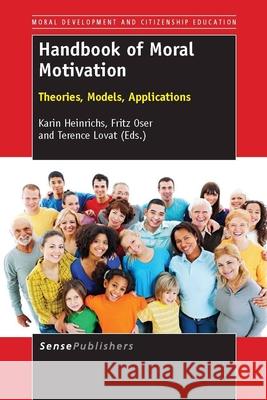Handbook of Moral Motivation : Theories, Models, Applications » książka
Handbook of Moral Motivation : Theories, Models, Applications
ISBN-13: 9789462092747 / Angielski / Twarda / 2013 / 676 str.
Handbook of Moral Motivation : Theories, Models, Applications
ISBN-13: 9789462092747 / Angielski / Twarda / 2013 / 676 str.
(netto: 420,89 VAT: 5%)
Najniższa cena z 30 dni: 425,63
ok. 30 dni roboczych
Dostawa w 2026 r.
Darmowa dostawa!
The Handbook of Moral Motivation offers a contemporary and comprehensive appraisal of the age-old question about motivation to do the good and to prevent the bad. From a research point of view, this question remains open even though we present here a rich collection of new ideas and data. Two sources helped the editors to frame the chapters: first they looked at an overwhelmingly fruitful research tradition on motivation in general (attribution theory, performance theory, self-determination theory, etc.) in relationship to morality. The second source refers to the tension between moral judgment (feelings, beliefs) and the real moral act in a twofold manner: (a) as a necessary duty, and, (b) as a social but not necessary bond. In addition, the handbook utilizes the latest research from a wide range of disciplinary perspectives, wishing to suggest by this that the answer to the posed question will likely not come from one discipline alone. Furthermore, our hope is that the implicit criticism that the narrowly constructed research approach of the recent past has contributed to closing off rather than opening up interdisciplinary lines of research becomes in this volume a strong counter discourse. The editors and authors of the handbook commend the research contained within in the hope that it will contribute to better understanding of humanity as an inherently moral species.
The Handbook of Moral Motivation offers a contemporary and comprehensive appraisal of the age-old question about motivation to do the good and to prevent the bad. From a research point of view, this question remains open even though we present here a rich collection of new ideas and data. Two sources helped the editors to frame the chapters: first they looked at an overwhelmingly fruitful research tradition on motivation in general (attribution theory, performance theory, self-determination theory, etc.) in relationship to morality. The second source refers to the tension between moral judgment (feelings, beliefs) and the real moral act in a twofold manner: (a) as a necessary duty, and, (b) as a social but not necessary bond. In addition, the handbook utilizes the latest research from a wide range of disciplinary perspectives, wishing to suggest by this that the answer to the posed question will likely not come from one discipline alone. Furthermore, our hope is that the implicit criticism that the narrowly constructed research approach of the recent past has contributed to closing off rather than opening up interdisciplinary lines of research becomes in this volume a strong counter discourse. The editors and authors of the handbook commend the research contained within in the hope that it will contribute to better understanding of humanity as an inherently moral species.











